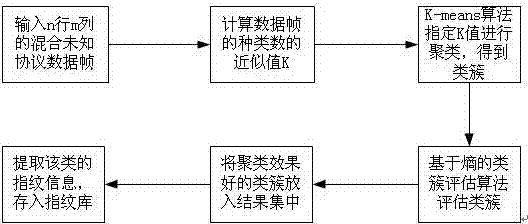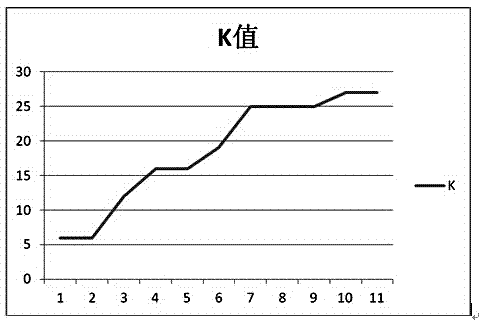Method for separating unknown multi-protocol mixed data frames into single protocol data frames
A technology of mixed data and protocol data, applied to electrical components, transmission systems, etc., can solve problems such as the difficulty of distinguishing different protocols, the low accuracy of protocol frame cluster evaluation, and the difficulty in calculating the number K of mixed protocols.
- Summary
- Abstract
- Description
- Claims
- Application Information
AI Technical Summary
Problems solved by technology
Method used
Image
Examples
Embodiment 1
[0083] Embodiment 1, the calculation of protocol type K is to take 27 kinds of protocols in Tcpdump, each of which takes 100 data frames, and if there are less than 100, all of them are taken; each data frame takes the first 68 bytes; the resulting protocols are mixed As input; variable settings: Liminal is set to 95, low_liminal is set to 10;
[0084] uniterate takes the corresponding K value from 50 to 99 records, the following is the brief experiment result of liminal=95; low_liminal=10; uniterate=99:
[0085] The maximum frame length is: 68;
[0086] Total number of frames: 2509;
[0087] Number of column stats: 68;
[0088] The number of sets in the candidate result set: 62;
[0089] The number of collections in the result set: 27;
[0090] Bytes: 00; Occurrences: 2379; Frequency: 0.9481865; Occurrences: Not shown;
[0091] Bytes: 10; Occurrences: 1172; Frequency: 0.46711838; Occurrences: Not shown;
[0092] Bytes: 7b; Occurrences: 700; Frequency: 0.2789956; Lines O...
Embodiment 2
[0122] Example 2, for the k-means clustering experiment:
[0123] data input:
[0124]For the 27 protocols in Tcpdump, take 100 data frames for each type, and take all of the less than 100 data frames; take the first 68 bytes of each data frame; mix the obtained protocols, and mark the protocol type after each data frame , for the Classes to clusters evaluation function of weka to evaluate the clustering effect.
[0125] Steps:
[0126] 1. Open the arff format file with weka.
[0127] 2. Use the StringToWordVector filter to process the text attribute. Set the WordCount parameter of StringToVector to flase, and use the default parameter settings for others. Each byte of the processed data stream represents an attribute. There are 256 attributes in total, and the attribute value is 1 or 0. 1 indicates that the attribute exists, and 0 indicates that it does not.
[0128] 3. Select the simplemeans clustering algorithm in weka for clustering, select Classes to clusters evaluati...
Embodiment 3
[0131] Example 3, clustering effect evaluation experiment:
[0132] Design the following two experiments, one is to use 2000 single-protocol data frames as input, and the other is to use 2500 multi-protocol mixed data frames as data, and then compare and analyze the obtained entropy values to judge whether the clusters are good or bad .
[0133] (1) The entropy value of each column of 2000 single agreements is calculated as follows:
[0134] column number
entropy value
column number
entropy value
column number
entropy value
1
1.73797
15
0
29
2.923939
2
2.579031
16
0
30
3.635007
3
3.253605
17
0
31
4.842482
4
3.443339
18
0
32
5.652463
5
3.573282
19
0
33
0.677264
6
3.781037
20
0
34
2.003118
7
0.739385
21
0
35
3.112292
8
2.533421
22
1.30097
3...
PUM
 Login to View More
Login to View More Abstract
Description
Claims
Application Information
 Login to View More
Login to View More - R&D
- Intellectual Property
- Life Sciences
- Materials
- Tech Scout
- Unparalleled Data Quality
- Higher Quality Content
- 60% Fewer Hallucinations
Browse by: Latest US Patents, China's latest patents, Technical Efficacy Thesaurus, Application Domain, Technology Topic, Popular Technical Reports.
© 2025 PatSnap. All rights reserved.Legal|Privacy policy|Modern Slavery Act Transparency Statement|Sitemap|About US| Contact US: help@patsnap.com



